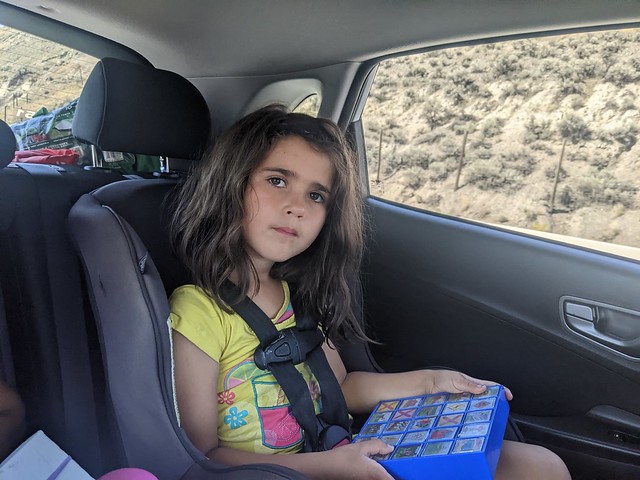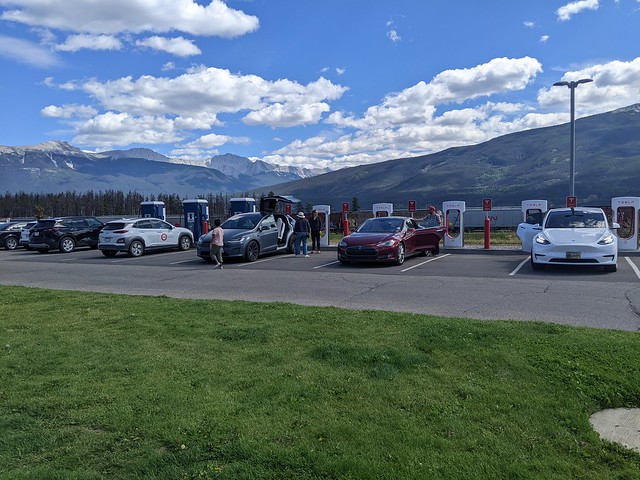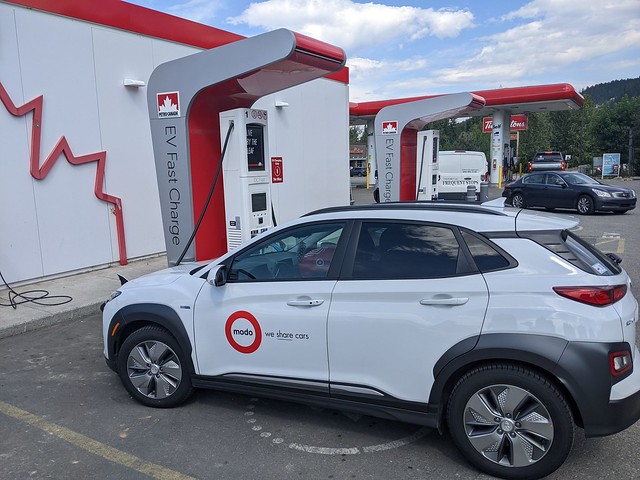When I was a kid, we did a big Canadian road trip in the summer with a new destination every year. Grand places like Saskatoon, Abbotsford, and Niagara Falls – wherever the Slo-Pitch Nationals were being hosted for my dad’s softball team. I have fond memories of those trips and the corners of Canada we visited.
And yet, I’ve never been keen to reproduce it with my family. Who wants to put up with the constant “I’m bored. Are we there yet?”
However, when my dad invited us to a big family get-together in Manitoba, we decided to drive and do some camping in the Rockies on the way. And for extra adventure and a lower carbon footprint, we resolved to make the trip in an electric vehicle.
I’m happy to report that with a little extra effort and planning, it is possible to drive from Vancouver to Sandy Lake, Manitoba, in an electric vehicle. It is also way cheaper. Over our entire trip, we drove 5,156 km and spent only $260 on charging. In a non-electric car, we would have spent $630 on gas! (Assuming 7 L/100 km and $1.75/L)
Renting an EV is getting easier. Hertz recently started adding EVs, and Vancouver has a Tesla rental company ZeroCar, but we decided to use our local car-sharing organization Modo. Modo currently has 23 EVs in its fleet and is steadily adding more, with a goal of being 100% zero emissions by 2030.
We took a 2020 Hyundai Kona Electric on our road trip, which has a theoretical range of 415 km on a full charge. The trunk space was a little tight, but with some creative packing (including using the wheel well under the trunk floor), we squeezed all of our camping gear and clothes in.
The first step in planning our trip was to map the route on PlugShare‘s website to see where we could charge along the way. We didn’t end up following the planned route (our charging strategy evolved as we went), but it was still valuable to know where we had lots of charging options (most of BC) and where charging stations were limited (Saskatchewan).

At that point, we noticed that there weren’t any fast chargers in Yorkton. In fact, there isn’t a single fast charger between Portage La Prairie and Saskatoon. An 800 km stretch of the Yellowhead Highway is an EV dead zone. The only way we could travel back from Sandy Lake via Saskatoon was to detour south through Regina, adding 75 km to our trip.

A quick technical note about EV charging. There are 3 types of chargers:
Level 1 – Uses a normal 120 V household socket. Takes 50 hours to fully charge. Not very useful for long roadtrips, but we used these sometimes at hotels to get some extra range.
Level 2 – Special chargers that put out more power. Often free. Takes 8 hours to fully charge. Great for overnight parking or anywhere else you’ll be for a few hours, like a mall or museum.
Level 3 – Also known as DC Fast charging. Takes 20-30 minutes to charge to 80% (like fast charging your phone, the charging speed decreases as it gets closer to 100%). These are key to making road trips work. Labelled with orange icons on PlugShare’s maps.
Lessons Learned
There are too many charging networks and apps. Too often the only way to pay is through your phone (or a special RFID card you have to order ahead of time in the mail). It’s not much fun spending 10 minutes installing a new app and setting up an account before you can even start charging.
EV owners are very friendly and helpful. We had nothing but positive interactions with people at charging stations. Someone even offered to pay for our charge when we struggled to install a new app. Even when there were more vehicles than chargers available (which only happened twice), people went out of their way to help each other out, offering to stop charging early to shorten waits.
Chargers can be unreliable. Pull into any gas station, and the experience is predictable, almost boring. Pull into a fast charger, and you have no idea what the price is or if it will even work. Usually, everything went smoothly, but we ran into some issues – a dead terminal, broken payment processing, a charger that would work for 2 minutes and then disconnect, or a charger that gave out way less power than expected.
Electrify Canada and Flo had the most reliable chargers. Petro Canada has done a great job blanketing the Trans Canada Highway with fast chargers, but we had problems with them on a few occasions.
PlugShare is an essential app. When we ran into problems, we didn’t know if we were doing something wrong, the car was having issues, or the charger was broken. The PlugShare app was a lifesaver here, and we learned to read the reviews before we arrived so we knew what to expect and what stations to avoid.
Waiting 20-30 minutes to charge is fine. One of the big disadvantages of electric vehicles is how long they take to charge, but it was never a problem for us. On a long road trip with a kid, it was nice to have consistent breaks to get out of the car, use the washroom, find food, do some quick shopping, or explore a playground. By then our car battery would be above 80% and ready for the next leg.
200 km is our ideal distance between charges. We usually had around 350 km of maximum range for each leg (after charging to 80%-90%), but that could disappear quickly if we drove uphill, into headwinds, or had the air conditioning on. Luckily after 2 hours in the car, someone invariably had to pee. When we had the choice, this is when we would stop to charge. This helped avoid any range anxiety (although I obsessed over how quickly it was dropping), and only once did we arrive at our destination with less than 50 km of range left.
EVs have a separate 12V battery. We woke up one morning while camping to discover our car wouldn’t start. The battery was dead. We were 35 km from the nearest charger and freaking out until Modo customer support told us we just needed to find someone to jumpstart the car. “But it’s an EV!”, I replied. Apparently, there is a standard 12V battery that is separate from the main battery pack. Some newer EVs have a button that will recharge the 12V from the main battery pack, but ours didn’t.

Modo’s prices are all-inclusive but you need to submit charging receipts. Our rental price covered insurance, mileage, and even parking (in Vancouver). So technically, the $370 we “saved” on gas vs charging is money Modo saved, not us, but as a member-owned co-operative we all win. Unfortunately, we have to submit the receipts for all of our charges (a huge pain). Modo vehicles have a gas card that works at almost any gas station and a ChargePoint card that wasn’t accepted at any of the chargers we used.
Thoughts About the Future
Electric vehicles are clearly viable now for most Canadians. They’re way cheaper to operate and maintain; they’re super efficient for city driving (thanks to regenerative braking), and fast charging makes long road trips possible.
The infrastructure is inconsistent, but it is getting better. More stations are constantly being added, filling in the gaps that make some stretches hard to drive right now. Soon we’ll see pricing per kWh (it’s currently illegal) instead of per minute, which will make charging prices fairer and easier to understand.
If I could make 3 improvements, I would:
- Standardize the plug so that any EV can charge at any station. Currently, there are CCS, CHAdeMO, and Telsa plugs that are incompatible, which is about as dumb as having Honda-only gas stations.
- Add more chargers to places where people want to stop. Rest areas, shopping malls, and restaurants should have fast chargers. Hotels and tourist attractions should have slow chargers.
- Ensure credit card payments are accepted at every charger to make payment easier. I like having an app to let me know how charging is progressing, but it shouldn’t be required to use the charger.
If we were in the market for a new vehicle, we would definitely be on the waitlist for an EV. No hesitation. But this trip hasn’t convinced us to buy a car. We’re happy that Modo is adding more electric vehicles we can use when we need one. We’re even happier to use our bikes and public transit for our regular transportation needs. EVs are great, but they’re not a climate solution on their own. We still need dense, walkable cities, more people cycling, better public transit, and viable high-speed rail for inter-city trips.
We made the most of our road trip to Sandy Lake with camping in Banff and Jasper, rides at the Saskatoon Ex and West Edmonton Mall, and road side stops to see the Birtle dump ogres and Vegreville Pysanka. But we have no plans on making a big road trip every summer. Driving is still a chore and we’d much prefer to take the train.
More photos from our road trip and amusement park visits.
















[…] but I rented one in the summer and drove it from Vancouver to Manitoba. I learned a lot on that road trip about driving an EV, the different kinds of chargers, and range […]
LikeLike
[…] made a cross-country road trip with an electric vehicle. Spent a week with cousins in Manitoba. Unleased the wild side. […]
LikeLike